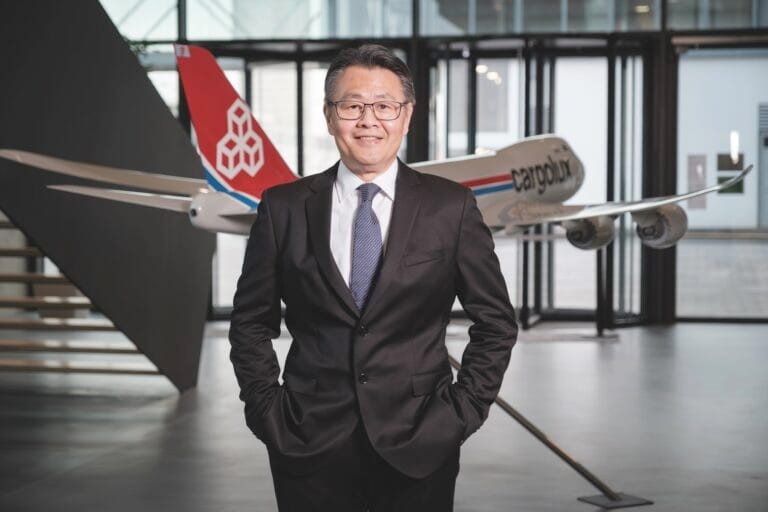- Globalisation is evolving rather than ending, with companies diversifying production across regions while balancing costs, labour availability, and regulatory challenges, according to Cargolux CEO Richard Forson.
- Digitalisation and AI are enhancing efficiency in air cargo, but human interaction—especially with freight forwarders—remains essential for complex logistics and customer relationships.
- Iconic freighters like the Boeing 747, with nose-loading capability, remain irreplaceable for specialised oversized cargo, though ageing fleets and rising costs mean most will retire by 2050.
The end of globalisation has been widely debated in recent years, fuelled by pandemic supply shocks, rising geopolitical tensions and calls for reshoring. But according to Richard Forson, President and CEO of Cargolux Airlines International, it would be wrong to declare globalisation dead.
Instead, he argues, it is simply changing shape: “They were really focused on getting everything out of one country. Now they want to start diversifying their sources of production,” he told the BBC. “I think that all is likely to take place to some extent, but it’s not going to happen overnight.”
Forson cautions that bringing manufacturing back home is far more complex than it sounds. Labour shortages, high costs and red tape remain major obstacles. “Bringing production home, unfortunately, I don’t think is going to be the answer, because cost is a big issue,” he said. “And also whether the labour force is available or not.”
In Southeast Asia, countries such as Vietnam and Cambodia may provide lower labour costs than China, but, he noted, it takes time to train workers for high-value industries. In Europe, meanwhile, bureaucracy and limited energy supply make expansion difficult. “If you take the EU, for example, it’s very difficult to get all of the necessary permits,” he said. “Then you’ve got the power needs—where is all the power going to come from to power these things? It doesn’t exist today.”
Forson believes that while some industries may tilt towards regionalisation, breaking up global trade entirely would be too costly. “To try and break it apart will cause huge challenges. And the people who are going to be paying for that is the consumer. They’re either going to be prepared to pay a lot more for what they get, or they’ll have to limit their choice.”
Fewer options, he adds, might not be such a bad thing in an era of climate awareness. “Instead of having 10 different types of an item, there’s two or three. That’s it,” he said. “You cut back on emissions, you cut back on wastage, you cut back on utilisation of resources.”
Human touch in a digital world
Cargolux, like many in the air cargo sector, is adapting to rapid technological change. Partnerships with digital booking platforms have opened up new channels for customers. But Forson is quick to stress that the fundamentals of freight relationships remain intact.
“Ultimately, it’s just more middlemen in between yourself and the final customer,” he explained. “With the forwarders, they are our traditional customer. Our focus is to make the process with our forwarders as seamless as possible for their customers.”
For him, freight forwarders still play an essential role. “At the end of the day, I still believe that it’s a middleman that serves a purpose,” he said. “But the major transactions are still going to be done, in my view, with our major customers.”
Artificial intelligence, too, offers potential in areas such as route optimisation and carbon tracking, but Forson says it is far from replacing human interaction. “Yes, it will enhance the ability to track seamlessly with our customers, in terms of looking at allotments or block space agreements or making bookings. But I believe that there’s still the need for the human, face-to-face element in doing business. You can’t just rely on machines.”
The 747 nose door
As production networks evolve, so too must the aircraft that carry the world’s cargo. But one of aviation’s most iconic designs—the Boeing 747 – with its distinctive nose-loading capability—is unlikely to ever be replaced. “You know, the nose door has obviously been the iconic staple of the 747, but it’s been an incredibly useful tool,” Forson said. “Especially when you’re looking at certain specialist logistic operations.”
He doubts any manufacturer will develop a true successor. “There’s nothing that can replace the nose door,” he explained. “The design of the 747 lent itself towards a nose. If you look back at the history, it was actually developed as a freighter for the military versus the C-5 Galaxy, so they had that requirement there.”
Most modern freighters are converted passenger aircraft, which don’t require a nose door. “I doubt very much whether any of the manufacturers will develop an aircraft specifically to be a freighter,” Forson said. “Passenger versions, unfortunately, don’t need nose doors.”
With rising maintenance costs and ageing fleets, Forson predicts most 747s will be retired by 2050—if not sooner. “Maybe one or two will keep on flying, but not on a very intensive basis,” he said. “It might become something like the AN-124 that currently flies around now.”
Without the nose-loading option, oversized cargo will face more constraints and higher costs. “You’re only going to use it when you have very special cargo to fly… difficult to get to the side door, so the nose going straight in, straight out. And that’s the lost capability that goes with the 747.”





